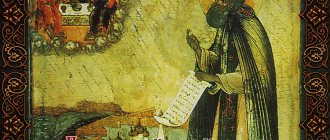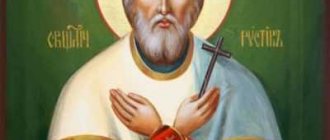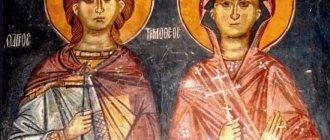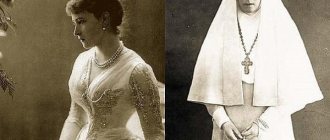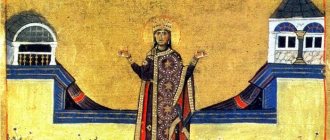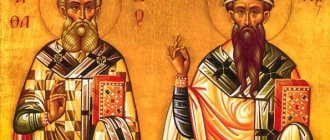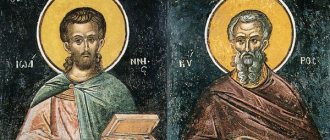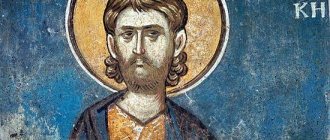Life of St. Savvaty of Tver
Almost no information has been preserved about the childhood and worldly life of the Monk Savvaty. The Tver province is considered the homeland of Savvaty, but where exactly he was born, whose son he was and at what age he became a monk - there is no information about this. It is only known that, before settling in the desert, Savvaty took a trip to Jerusalem and brought from there a particle of the life-giving cross of the Lord. Before the trip and for some time after returning from Jerusalem, Savvaty was a monk of the Tver Orshin Monastery.
Wanting solitude, he retired to a deserted area a few kilometers from the Orshin Monastery, closer to Tver, and built himself a small cell there with his own hands. Over time, other monks began to settle near it, a church was built and the 4350 Savvatiev Hermitage , which, due to the severity and holiness of the rules of its founder, was so famous that the venerable Cornelius of Komel and Joseph of Volokolamsk and other prominent religious people came to it to study monastic life figures of that time.
Savvaty, with his exploits and fiery prayer, served as an example for everyone: he was tireless in work, exhausted himself with strict fasting and abstinence, and wore heavy iron chains on his body (the chains attributed to the monk were sent to the Holy Synod in 1848 and were kept in its Archives).
The year of death of Savvaty of Tver is unknown: some sources indicate that he died no later than 1409, others - no later than 1434.
The relics of Father Savvaty, discovered in 1483, were hidden in the Savvatiev Monastery. Later, the monastery was abolished and turned into the parish church of the village of Savvatieva, and after the October revolution, many buildings were destroyed by the Bolsheviks (including all the old churches and the cell (forest dugout) of the saint).
Orthodox Church calendar
Brief life of St. Savvaty of Tver
The Monk Savvatiy of Tver labored with the blessing of Saint Arseny, Bishop of Tver, 15 versts from Tver. There, the Monk Savvaty founded a monastery, known for the severity and holiness of its rules. Such ascetics as the Venerable Joseph of Volotsk (September 9) and the Venerable Cornelius of Komel (May 19) came there to study monasticism. The chains found in the cave where Saint Sabbatius was silent testify to his feat. The saint reposed no later than 1434.
Complete life of St. Savvaty of Tver
Starting from the time of Ivan Kalita, the center of Russian church life moved to Moscow. Against this background, many saints who labored in appanage principalities lose their national significance. This situation intensified in post-Petrine times, when the frequent movements of bishops from see to see led to the fact that the bishops did not even know the ascetics who were glorified within their diocese. The Tver saints were very unlucky in this regard. The Tver diocese, being quite prestigious, was also a gateway - from it young bishops were sent to high places in St. Petersburg, Moscow or Kyiv. Today we will talk about one of the most significant Tver ascetics - St. Savvaty of Tver and Orsha.
Details of the life of Rev. Savvatiya are not fully known. He was born in the middle of the 14th century. He took monastic vows and labored in the Orsha Ascension Monastery, which was still a men’s monastery at that time. In the 1380s he traveled to the Holy City of Jerusalem, where he became acquainted with the life of Palestinian monasticism. Returning to his native monastery, he decided to switch to desert living. For this purpose, having asked for the blessing of his confessor, Saint Arseny, he retired to a dense forest up the Orsha River, where he excavated a cave in which he prayed for the salvation of human souls. There the monk dug a pond, and on the bank of the river, through the prayers of the saint, a celibate spring appeared. Soon the brethren began to gather around the Monk Savvaty. This is how the Savvatyevsky Monastery arose. The saint was in fraternal correspondence with St. Sergius of Radonezh, Cornelius of Komel and many other holy monks. The monastery established by the Monk Savvaty was considered one of the most strict and organized. St. Petersburg came here in search of a role model. Joseph of Volotsk, and although he no longer found St. Savvaty is alive, but learned a lot from his student and successor, St. Euphrosyne. Even during the life of St. Savvaty became famous for his miracles. Through his prayer, the daughter of Tver Prince Boris, Maria, the future wife of Ivan III, received healing. Rev. died Savvaty ok. 1438 Subsequently, his monastery suffered the fate of many Russian monasteries. It was closed in the 18th century. The relics of St. Savvaty rested in the parish church of the village. Savvatyevo, now this temple is destroyed and the fate of St. relics are unknown.
One of the most famous holy springs in the vicinity of Tver is the well of Savvaty Tverskoy and Orshinsky near the village of Savvatyevo on the banks of the Orsha River.
The holy spring is almost the only thing that has survived from the ancient monastery of Savvatiev Hermitage, which was demolished in 1936. Water from the holy spring has miraculous powers - it heals many diseases.
According to legend, the well and the pond next to it were dug back in the 14th century by the Monk Savvaty of Tver himself, who lived here as a hermit. In the forest not far from the holy spring there was a cave in which the venerable elder lived.
At the beginning of the 15th century, Savvatiy founded the monastery of Savvatiev Hermitage, and in the 16th century, the well dug by the monk was consecrated and became a place of pilgrimage.
Well of Savvaty Tverskoy and Orshinsky
Around the 1970s - 1980s, the cave where the Monk Savvaty lived and the holy spring with wonderful water located next to the cave were filled up. But the people did not cease to venerate Saint Savvaty of Tver. Thus, on the site of the destroyed cave, believers installed a golden cross, which previously crowned the dome of one of the blown-up churches of the monastery. Today this cross stands at the holy source of St. Savvaty.
In 2000, the well of St. Savvaty was rebuilt, and two years later the stream flowing from it was restored.
The holy spring flows from a sandy slope directly on the banks of the Orsha River. The spring reservoir is taken into a concrete well. Several icons are attached to the trees near the source of St. Savvatius, and information about the life of the saint is posted. Near the holy spring, a small wooden chapel was built and a bathhouse was arranged.
Today the holy spring of St. Savvaty belongs to the Orshin Ascension Monastery for women. Every year for more than ten years, on January 19, on the feast of the Epiphany of the Lord, and on March 15, the day of memory of St. Savvaty of Tver, a procession of the Cross goes from the monastery to the well, and a prayer service is held at the holy source itself, attended by the nuns of the Orshina Ascension Monastery and numerous believers from Tver and surrounding villages.
Many Tver residents constantly come to the holy spring of St. Savvaty for water - spring water is incredibly tasty.
Moreover, the water from the holy spring has miraculous powers. For centuries, people suffering from illnesses from all over Russia came to pray to the venerable elder and drink the water of the spring. And many of them returned home completely healthy. And today many who thirst for healing come to the well of St. Savvaty.
well of Savvaty Tverskoy and Orshinsky
The website of the Savvatyevsky Monastery contains numerous stories of miraculous healing. Here is the story of Inna Gorokhova from the village of Avvakumovo, Tver region: “I suffered from chronic bronchitis for many years. Autumn, spring - these were the most terrible times for me. Two years ago in the fall, I suffered from a terrible cough for a week. No medications helped. And so, on Sunday I went with pilgrims to the Savvatyev Hermitage for a prayer service to the Reverend Elder. I ordered a prayer service and asked him to heal me from my cough. That day there was severe frost and snow fell, but during the prayer service, as expected, I drank ice water from the source. I took the water home and, as soon as I started coughing, I drank the water and doused my head and neck with this water. This went on all night. On Monday morning the cough was gone. By the grace of God and through the prayers of St. Savvaty, I was almost completely healed of bronchitis. I no longer had coughing attacks.” A resident of the city of Tver, Vera Alexandrova, tells how water from the well of St. Savvaty helped her get rid of sinusitis, and a resident of Tver, Tatyana, talks about how her husband, immersed in the font, was cured of varicose veins in his legs.
Address: Russia, Tver region, Kalininsky district, Kablukovsky rural settlement, Savvatyevo village.
Directions: The distance from the village of Savvatyevo to Moscow by road is approximately 180 kilometers, and to the regional center of Tver - exactly fifteen kilometers.
When getting to the holy spring from the capital by private car, you need to take the federal highway M10 (Leningradskoye Shosse) to Tver, then along the Savvatyevskoye Highway to the bridge over the Orsha River. From the bridge to the well you need to walk about 800 meters.
You can also get to the spring by public transport: Tver has excellent train and bus connections with Moscow and St. Petersburg. From the city center you can get to the key of St. Savvaty by municipal bus No. 121 or by minibus No. 77. You need to get off at the stop at the bridge over Orsha.
The convenient location of the spring of St. Savvaty of Tver has led to the fact that the holy spring is visited by numerous pilgrims from all over Russia and the CIS.
Savvaty and his disciple Euphrosynus of Tver, reverend
The handwritten description of the Tver saints says: “Reverend Savvaty, abbot of the desert, sits in the image of the Lord, like John the Theologian.” The monk labored with the blessing of Saint Arseny, Bishop of Tver, 15 versts from Tver. The Savvatieva hermitage was so famous for the severity and holiness of the rules of its founder that such lovers of piety as St. Korniliy of Komel (May 19/June 1) and Joseph (Volotsky) of Volokolamsk (September 9/22). The latter no longer found the saint himself alive. Savvaty, whose blessed death followed no later than 1434. The chains found in the cave show the asceticism of St. Savvaty is against the flesh, and the cave, a witness to his pure, silent prayers, says that being with the people of the desert was not always easy for his soul, and from time to time he hid in the cave to talk with the Lord. The life of his student can partly show us how the teacher lived.
A student and worthy successor of St. Savvatiy in charge of managing the desert was St. Euphrosyn. During his abbess, St. Petersburg came to the monastery. Joseph of Volotsky (Volokolamsky), who recorded the following about his visit: “I saw a holy elder hermit named Euphrosyne in the Savvatiev desert. He was from the princes of Teprin. He lived hopelessly in the desert for about 60 years. Many monks, princes and boyars came to him for advice, interrupting his silence. Then he fled from people's rumors to Veliky Novgorod, to Lake Nevo (Ladoga), found an island and lived there for several years. The surrounding residents, having heard about the ascetic, began to flock to him with their wives and children, and he was again forced to hide, now to the Savvatiev Hermitage. The ruler of that land - Prince Boris Alexandrovich - sent to him his young daughter, then the betrothed bride of Grand Duke John Vasilyevich; Archimandrites, abbots, and boyars came with her and began to ask Blessed Euphrosynus to pray for the girl: she was very sick and they brought her into the desert to the blessed one in their arms. He refused, calling himself unworthy and a sinner. They begged the saint with tears, saying: “If she remains alive through your prayers, then, father, you will pacify the two principalities.” Seeing that the girl fell into a serious illness, St. Euphrosynus ordered her to be taken to the church, and he himself began to pray with tears and sobs in front of the icon of the Most Holy Theotokos. Then he ordered to sing a prayer service to the Most Holy Theotokos and St. Nicholas. When the prayer service ended, the girl opened her eyes and sat down. Those who brought her picked her up healthy and on the same day took her to her father, glorifying God, “who gives grace to His saints.” St. Euphrosynus, who was granted the gift of miracles by God, was deeply revered by the people, princes and boyars. The saint died peacefully around 1460.
Share on the page
Next chapter >
Troparion and kontakion to St. Savvaty of Tver
Troparion, tone 8.
ABOUT! you, Father Savvaty, know the speed of salvation. Let us accept the cross, for you followed Christ. But whoever does and learns to despise the flesh passes away, but to practice things more immortal for the soul. In the same way the angels rejoice, O venerable spirit.
Kontakion, tone 2.
Having divinely armed yourself with spiritual purity, and unceasing prayer, as if you had firmly handed over a copy, you prosecuted the demonic army of Savvaty, our father, pray unceasingly for all of us.
Rev. Savvaty of Tverskoy. Icons
The Monk Savvaty of Tver is traditionally depicted on icons in monastic vestments, with a blessing hand. The iconographic image of St. Savvaty praying to the Cross is also known.
Rev. Savvaty of Tverskoy. Cover
Monastery of St. Savvaty of Tver, with scenes from his life. XVI century. Moscow, Central Museum of Ancient Russian Culture and Art named after Andrei Rublev
Reverend Savvaty Tverskoy at work
Znamensky Cathedral of the Savvatievsky Monastery
Venerable Savvaty of Tverskoy in prayer to the Cross. Tver, second quarter - mid-16th century. Moscow, Central Museum of Ancient Russian Culture and Art named after. Andrey Rublev
Reverence
Subsequently, a church in the name of the Holy Trinity was built on the site of the chapel. Then Rev. Zosima restored the deserted monastery of Savvaty on Solovetsky Island and in 1471 transferred the relics of the saint to the island to the Church of the Transfiguration, built on the spot where the holy hermits Savvaty and Herman first erected a cross.
Church-wide glorification of the saint by the Russian Church followed at the Moscow Council in 1547. On August 8, 1566, the relics of Saints Savvaty and Zosima were transferred to the chapel, built in their name, near the same Church of the Transfiguration, where they rested in a silver shrine until the revolutionary hard times.
In 2022, his name was included in the list of the Cathedral of Saints of the Archangel Metropolis [2].
Savvatiev Monastery
The first monastery church was built by the Monk Savvaty. It was a small wooden church in honor of the icon of the Most Holy Theotokos “Burning Bush”. Later a stone church was built on this site. Gradually, with the support of the residents of Tver, the monastery grew.
By the end of the 17th century, the monastery was prosperous and had significant estates, including a courtyard in the Tver Kremlin. The five-domed Sretensky Cathedral with the chapel of St. Nicholas the Wonderworker and the hipped bell tower is a typical monument of Moscow architecture from the pattern era - erected in 1674, presumably on the site of a stone building from the 16th century. The painting of the temple dates back to 1893. In 1901 the porch was rebuilt. The Znamenskaya Church was erected by Abbot Tikhon at the end of the 17th century (no later than 1693). During Peter's time, the Savvatyevsky Monastery began to decline and with the beginning of Catherine's secularization (1764) it was abolished, becoming an ordinary rural parish. Nevertheless, its temples remained a place of pilgrimage.
Worship services ceased in 1935, after which many buildings were destroyed. The revival of the Savvatieva Hermitage began in the late 1990s. In 2001, on the foundation of the Znamenskaya Church, they began to build a new one, in the traditions of Pskov architecture, with a belfry, and on June 28, 2003, a worship cross was erected on the site of the destroyed Sretensky Cathedral.
Savvatiev Monastery. Znamenskaya Church
Prepp. Savvas, Barsanuphius, Savvatiy and Euphrosyne of Tver
March 14th 2012 —
Memory March 2/15
Venerable Barsanuphius of Tver, abbot, elder brother of Blessed Sava.
He was appointed abbot of the Savvina Sretensky Monastery by the Reverend Abbot Savva of Vishersky, who was going on a pilgrimage to the Holy Mountain.
After five years of ruling the monastery, the Monk Barsanuphius withdrew into the desert, transferring the abbess to his brother, the Monk Sava, and commanded him to take holy orders, for “he was pure from his mother’s womb and worthy of such grace.”
The Monk Barsanuphius lived in solitude for forty years.
The Monk Joseph of Volotsky testifies: “in all these years he had no other thing to do than pray, sing and read books. He took books from Christ-lovers and gave them away after reading them, then took them elsewhere. The blessed one had nothing, not even a copper coin, for he loved poverty and lack of wealth. For his long attention to himself, silence, prayers and reading of holy books, he was awarded such grace that he remembered all the Holy Scriptures by heart and freely passed them on to anyone who asked. Many monks and worldly noble people came to him from everywhere, some for spiritual benefit, others demanding clarification of some passage of Scripture. Even the Metropolitan of All Rus', Photius, from time to time sent to him with a request to give an explanation for an incomprehensible saying of the Holy Scriptures, about which he had a dispute with someone.”
There is a known case when one of the brothers, seduced by a demon, decided to steal books from the monk’s cell and fell dead on the threshold with books in his bosom. It was only thanks to the prayers of Saint Barsanuphius that the unfortunate man was resurrected and subsequently labored worthily in the monastery until the end of his days.
Having reached a very old age, the Monk Barsanuphius returned to the monastery to his brother, the Monk Savva.
Rev. died Barsanuphius a little earlier than 1467.
Blessed Savva, Bishop of Tver
Younger brother Rev. Barsanuphius of Tver, who replaced him as abbot of the Sretensky Tver Monastery. For more than half a century he was abbot, monitoring the observance of discipline in the monastery in a way that was unusual even at that time: whether anyone was late for the beginning of the service, or left before the end, or talked during prayer, or even simply moved from one place to another in the church places to another, - Savva severely punished the offender. He made sure that there was no “secret eating” - that everyone ate at a common meal, without feasting on anything in solitude. When Savva died, the abbot who replaced him weakened the order in the monastery - then the saint appeared to him in a dream and beat him so badly with the abbot’s staff that, upon waking up, the poor fellow became seriously ill and, even having recovered, did not dare to remain at his post. Such severity (it was admired and described by St. Joseph Volotsky) usually does not fit well with the idea of modern people (especially intelligent ones) about meekness and love obligatory for Christians: but meekness, although obligatory, does not necessarily mean cowardice, just like love, in contrast from falling in love, he definitely knows how to use power and even, if necessary, a club, he knows how to repel the evil and firmly hold the armpits of the weak, he knows how to teach people, because he knows how to learn from Christ.
Before becoming a bishop, he served as abbot in the monasteries of the Pskov diocese: from 1563 - in the Snetogorsk Nativity of the Virgin Mary Monastery and from 1571 - in the Pskov-Pechersky Monastery. In the latter, during his rectorship, by order of Tsar John Vasilyevich IV, the miraculous icon of the Dormition of the Blessed Virgin Mary was overlaid with gold.
At the beginning of 1572, Abbot Savva was consecrated Bishop of Tver.
On April 29 of the same year, he was present at the council that permitted the fourth marriage of Tsar Ivan Vasilyevich.
He ruled the diocese until 1573.
There is no information about his death.
Rev. Savvaty of Tverskoy.
He labored with the blessing of Saint Arseny, Bishop of Tver, 15 versts from Tver. There, the Monk Savvaty founded a monastery, known for the severity and holiness of its rules. Such ascetics as St. Joseph of Volotsk and St. Cornelius of Komel came to it to study monasticism.
The chains found in the cave where Saint Sabbatius was silent testify to his feat.
The saint reposed no later than 1434.
Disciple and successor of St. Savvatiy in charge of managing the desert was St. Euphrosyn Tverskoy
Venerable Euphrosynus of Tver, abbot
Originally from the princes of Teprin, he was a student and successor of the Monk Savvaty in governing the Savvatyev Hermitage. During his abbess, the Monk Joseph of Volotsky came to the monastery, from whose records we know about the monk.
In the desert St. Euphrosynus lived hopelessly for 60 years. Many monks, princes and boyars came to him for advice, interrupting his silence. Then he fled from people's rumors to Veliky Novgorod, to Lake Nevo (Ladoga), found an island and lived there for several years. The surrounding residents, having heard about the ascetic, began to flock to him with their wives and children, and he was again forced to hide, now to the Savvatiev Hermitage. The ruler of that land - Prince Boris Alexandrovich - sent to him his young daughter, then the betrothed bride of Grand Duke Ivan Vasilyevich; Archimandrites, abbots, and boyars came with her and began to ask Blessed Euphrosynus to pray for the girl; She was very sick, and they brought her into the desert to Blessed Euphrosynus in their arms. He refused, calling himself unworthy and a sinner. They begged the saint with tears, saying: “If she remains alive through your prayers, then, father, you will pacify the two principalities.”
Seeing that the girl fell into a serious illness, the Monk Euphrosynus ordered her to be taken to church, and he himself began to pray with tears and sobs before the icon of the Most Holy Theotokos. Then he ordered to sing a prayer service to the Most Holy Theotokos and the great miracle worker, Nicholas. When the prayer service ended, the girl opened her eyes and sat down; Those who brought her picked her up healthy and took her to her father that same day, glorifying God, “who gives grace to His saints.”
The Monk Euphrosynus died peacefully around 1460.
